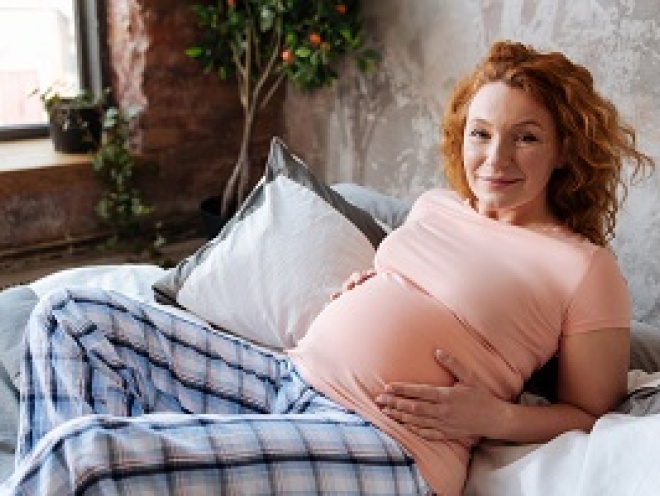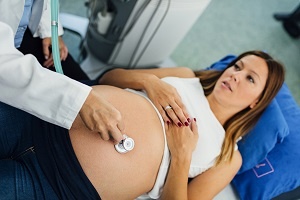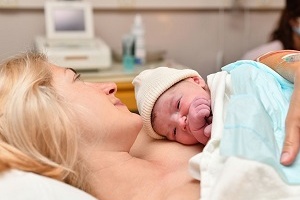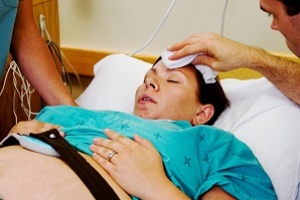What happens if you get pregnant after the age of 35 – are there any risks involved? We look at the facts about pregnancy and birth in your mid-thirties and later.
Getting pregnant at an older age may have its advantages. You might be more financially stable than you were when you were younger, and have more life experiences to bring to parenting. But while most older mums have healthy pregnancies and give birth to healthy babies, there is a higher chance of developing certain problems if you are 35 years or older.
Here we look at the experience of being pregnant and having babies at 35 and above.
Pregnancy and birth for older women
While most pregnancies lead to a healthy baby, the chance of problems during pregnancy rises slightly with age. Women over the age of 40 are at a higher risk of complications (RCOG, 2009).
These complication risks are:
- The association between later pregnancy and specific pregnancy difficulties like hypertension.
- Being more likely to have general age-related health conditions. This includes being more likely to have conditions like diabetes, obesity, and decreased cardiovascular reserve (the difference between the rate your heart pumps blood at and its full capacity to pump blood) (BPAS, 2015). You might be glad to know that, some research says that after the age of 35, having other medical conditions poses more of a risk to worse pregnancy outcomes than age itself. That means that if you’re healthy and haven’t had previous problems with pregnancy and giving birth, age is less of an issue (Morris et al, 2018).
- The increased chance that the birth itself will have more complications if you’re older (BPAS, 2015). If you’re over 40, you are likely to be offered additional monitoring and consultant-led care, as well as being offered induction of labour earlier (NICE, 2019).
Possible complications
Stillbirth and induction of labour
Although cases of stillbirth at term are low overall, they are slightly higher in older pregnant women. Try not to worry too much though; stillbirth is rare even in women over 40 (Knight et al, 2017). Women aged 40 and older have a two in 1,000 chance of stillbirth at 39 to 40 weeks pregnant, which is double that of women less than 35 years old (one in 1,000).
There are, thankfully, things that can decrease the risks of stillbirth. If you’re 40 or older, you might be offered induction of labour at 39 to 40 weeks, particularly if you have other complications (RCOG, 2013). This is because pregnant women over 40 have a similar stillbirth risk at 39 weeks of gestation to women in their mid-20s at 41 weeks of gestation (RCOG, 2013).
One large study suggested that induced labour at 40 weeks for women over 35 led to a 66% reduction in the chance of the baby dying at birth (Knight et al, 2017). This means that 562 inductions of labour at 40 weeks would be required to prevent one baby from being stillborn. Other things should be taken into account, such as the increased risk with induction of instrumental birth and emergency caesarean and how women might feel about being induced (Knight et al, 2017).
Miscarriage
The risk of miscarriage – losing a baby up to 24 weeks of pregnancy – does unfortunately increase as you get older. The risk of a pregnancy ending in miscarriage for women aged 30 is 18% (Tommy’s, 2018). That rises for women aged 35 to 22%. For women aged 40, this increases to 38% of pregnancies, and 70% for women aged 45.
There is still a lot we don’t understand about miscarriage. But one reason for miscarriage rates increasing with age is that older eggs are more likely to carry genetic faults (Miscarriage Association, 2015).
Down’s syndrome and other chromosomal anomalies
One of the most well-known risks of having a baby later is the chances of certain types of fetal anomaly. In particular Down's, Edwards' and Patau syndromes (trisomies 21, 18 and 13).
The chance of having a baby with Down’s syndrome increases from less than one in 1,000 under age 30 to one in 400 for women who become pregnant at 35. The likelihood of Down’s syndrome continues to increase as a woman ages. So by age 42, the chance that a pregnant woman will have a baby with Down’s syndrome is one in 60. By age 49, the chance is one in 12 (BPAS, 2015).
High blood pressure and pre-eclampsia
Being 40 and over is a moderate risk factor for pre-eclampsia during pregnancy (NICE, 2019). That means you might be offered more frequent blood pressure measurements. If you are aged 40 or older and have any more risk factors for pre-eclampsia, you might also be offered daily aspirin from 12 weeks of pregnancy (NICE, 2011).
Labour and birth
There are small increases in most pregnancy - and birth-related complications with age. These complications include increased risks of getting gestational diabetes, placenta praevia and of your baby being in the breech position. You’re also more likely to need an emergency caesarean, or experience a postpartum haemorrhage or prolonged labour.
The reasons for the increased risks are not fully understood. Research does suggest that physiological and cellular changes with age, which affect how the uterus muscles contract, might be a factor (Patel et al, 2017).
Premature birth and low birthweight baby
Plenty of reports exist around older mothers having a higher risk of premature birth or low or high birthweight babies (Jolly et al, 2000; Luke and Brown, 2017). For example, one study found that mums aged 40 or over had a higher risk of preterm birth (Fuchs et al, 2018).
Yet there is debate about how much a mum’s age is a risk factor in itself. Some research suggests that the mum’s age itself is not a problem. The increased risk of early birth might be due to differences in circumstances, behaviour and other factors not related to age (Goisis et al, 2017).
Maternal mortality
While the risk of a mum dying during pregnancy or childbirth is really low in the UK, it does increase with age. Factors that might affect this for women over 35 include smoking during pregnancy and not taking advantage of antenatal care. Having existing medical conditions and previous pregnancy problems are also risk factors (McCall et al, 2017).
Benefits
If it all sounds like doom and gloom for older mums, it’s not the case. There are advantages of older motherhood.
Being ‘ready’ to have a baby is critically important for the ability to enjoy parenthood too. Older mums may be more prepared financially and socially to welcome a new baby into the world than they were at a younger age. And it might be a relief to hear that all of these factors can compensate, or even more than compensate, for the disadvantages connected with having a baby later in life (Myrskylä et al, 2017).
This page was last reviewed in November 2018.
Further information
Our support line offers practical and emotional support with feeding your baby and general enquiries for parents, members and volunteers: 0300 330 0700.
We also offer antenatal courses which are a great way to find out more about birth, labour and life with a new baby.
British Pregnancy Advisory Service (BPAS). (2015) What's the problem with older mothers? Available from: https://www.bpas.org/get-involved/campaigns/briefings/older-mothers/ [Accessed 1st February 2019]
Fuchs F, Monet B, Ducruet T, Chaillet N, Audibert F. (2018) Effect of maternal age on the risk of preterm birth: A large cohort study. PLOS ONE. 13(1). Available from: https://doi.org/10.1371/journal.pone.0191002 [Accessed 1st February 2019]
Goisis A, Remes H, Barclay K, Martikainen P, Myrslyla M. (2017) Advanced maternal age and the risk of low birth weight and preterm delivery: a within-family analysis using Finnish population registers. American Journal of Epidemiology. 186(11):1219-1226. Available from: https://www.ncbi.nlm.nih.gov/pmc/articles/PMC5860004/ [Accessed 1st February 2019]
Jolly M, Sebire N, Harris J, Robinson S, Regan L. (2000) The risks associated with pregnancy in women aged 35 years or older. Human Reproduction. 15(11):2433-2437 Available from: https://www.ncbi.nlm.nih.gov/pubmed/11056148 [Accessed 1st February 2019]
Knight HE, Cromwell DA, Gurol-Urganci I, Harron K, van der Meulen JH. (2017) Perinatal mortality associated with induction of labour versus expectant management in nulliparous women aged 35 years or over: an English national cohort study. PLOS Medicine. 14(11). Available from: https://journals.plos.org/plosmedicine/article?id=10.1371/journal.pmed… [Accessed 1st February 2019]
Luke B, Brown MB (2007). Elevated risks of pregnancy complications and adverse outcomes with increasing maternal age. Human Reproduction. 22(5):1264-1272. [Accessed 1st February 2019]
McCall S, Nair M, Knight M. (2017) Factors associated with maternal mortality at advanced maternal age: a population‐based case–control study. BJOG. 124(8):1225-1233. Available from: https://obgyn.onlinelibrary.wiley.com/doi/full/10.1111/1471-0528.14216 [Accessed 1st February 2019]
Miscarriage Association. (2015) Why me? Available from: https://www.miscarriageassociation.org.uk/wp-content/uploads/2016/10/Why-Me.pdf.[Accessed 1st February 2019]
Morris JM, Totterdell J, Bin YS, Ford JB, Roberts CL. (2018) Contribution of maternal age, medical and obstetric history to maternal and perinatal morbidity/mortality for women aged 35 or older. The Australian and New Zealand Journal of obstetrics and gynaecology. 58(1):91-97. Available from: https://www.ncbi.nlm.nih.gov/pubmed/28776640.[Accessed 1st February 2019]
Myrskylä, M, Barclay K, Goisis A. (2017) Advantages of later motherhood. Der Gynakologe. 50(10):767-772. Available from: https://www.ncbi.nlm.nih.gov/pmc/articles/PMC5633623/ [Accessed 1st February 2019]
NICE (National Institute for Health and Care Excellence). (2011) Hypertension in pregnancy: diagnosis and management. Clinical Guideline 107. Available from: https://www.nice.org.uk/guidance/cg107 [Accessed 1st February 2019]
NICE (National Institute for Health and Care Excellence). (2019) Antenatal care for uncomplicated pregnancies. Clinical Guideline 62. Available from: https://www.nice.org.uk/guidance/cg6 [Accessed 1st February 2019]
NHS Digital. (2018) Table 4.f: Age of mother by birth status. NHS maternity statistics, hospital episode statistics. Available from: https://files.digital.nhs.uk/07/9F94A7/hosp-epis-stat-hesnational-2017-18.xls [Accessed 1st February 2019]
Patel R, Moffatt JD, Mourmoura E, Demaison L, Seed PT, Poston L, Tribe RM. (2017). Effect of reproductive ageing on pregnant mouse uterus and cervix. The Journal of physiology. 595(6):2065-2084. Available from: https://www.ncbi.nlm.nih.gov/pmc/articles/PMC5350451/[Accessed 1st February 2019]
RCOG (Royal College of Obstetricians and Gynaecologists). (2009) RCOG statement on later maternal age. Available from: https://www.rcog.org.uk/en/news/rcog-statement-on-later-maternal-age/ [Accessed 1 February 2019].
RCOG (Royal College of Obstetricians and Gynaecologists). (2013) Induction of labour at term in older mothers. Available from: https://www.rcog.org.uk/globalassets/documents/guidelines/scientific-impact-papers/sip_34.pdf. [Accessed 1 February 2019].
Tommy's. (2018) Miscarriage statistics. Available from: https://www.tommys.org/our-organisation/charity-research/pregnancy-statistics/miscarriage [Accessed 1st February 2019]







